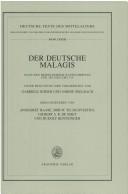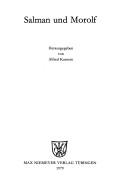| Listing 1 - 10 of 16 | << page >> |
Sort by
|
Book
Year: 1964 Publisher: Moskva : Nauka,
Abstract | Keywords | Export | Availability | Bookmark
 Loading...
Loading...Choose an application
- Reference Manager
- EndNote
- RefWorks (Direct export to RefWorks)
Book
Year: 1962 Publisher: Moskva : Izd-vo Akademii nauk SSSR,
Abstract | Keywords | Export | Availability | Bookmark
 Loading...
Loading...Choose an application
- Reference Manager
- EndNote
- RefWorks (Direct export to RefWorks)

ISBN: 3050021977 9783050021973 3050068752 Year: 2000 Volume: 82 Publisher: Berlin: Akademie,
Abstract | Keywords | Export | Availability | Bookmark
 Loading...
Loading...Choose an application
- Reference Manager
- EndNote
- RefWorks (Direct export to RefWorks)
Die von der Germanistik und von der Niederlandistik lange erwartete Edition macht einen Text zugänglich, der als versgenaue Umsetzung eines niederländischen Werkes ins Deutsche eine Vorstellung zu vermitteln vermag von der Gestalt des mittelniederländischen "Madelgijs", der bekanntesten, aber nur fragmentarisch erhaltenen niederländischen Bearbeitung eines Chanson de geste-Stoffes, des französischen "Maugis d’Aigremont". Das rund 23.000 Verse umfassende Epos über Malagis, den zauberkundigen Helfer der vier Haimonskinder, wurde zusammen mit den zwei eng verwandten Epen, dem 1885 bereits in einer modernen Ausgabe erschienenen "Reinolt von Montalban" und dem in absehbarer Zeit ebenfalls in den Deutschen Texten des Mittelalters erscheinenden "Ogier", im 15. Jahrhundert am Heidelberger Hof rezipiert. Die Edition des "Malagis" wie des "Ogier" werden daher in besonderem Maße zur Kenntnis der niederländisch-deutschen Literaturbeziehungen im Spätmittelalter und zur Erhellung des Literaturbetriebs eines spätmittelalterlichen Fürstenhofes beitragen. Die umfangreiche Einleitung zur Ausgabe gibt Auskunft über die handschriftliche Überlieferung und die inhaltliche Ausgestaltung des Stoffes in der deutschen, niederländischen und französischen Literatur sowie über die Abhängigkeit der verschiedenen Bearbeitungen des Stoffes. Leithandschrift für den Text des nur in zwei Handschriften des 15. Jahrhunderts überlieferten "Malagis" ist der Cpg 340. In einem Lesartenapparat sind die für das zeitgenössische Textverständnis aufschlussreichen Varianten des cpg 315, einer direkten Abschrift des Cpg 340, verzeichnet. In einem kommentierenden Apparat werden schwer verständliche Stellen erläutert und Konjekturen begründet, z. T. durch Hinweise auf die mndl. Fragmente, deren Beginn bzw. Ende am rechten Rand des Textes nach der Edition von Bob Th. W. Duijvestijn vermerkt ist. Ein Namenverzeichnis mit einer genealogischen Übersicht und ein ausführliches Glossar, das über ein bloßes Wortverzeichnis hinausgeht, beschließen den lange erwarteten Band, der das Ergebnis einer erfolgreichen interdisziplinären Zusammenarbeit von Germanisten und Niederlandisten aus mehreren Ländern repräsentiert.
German literature --- Chanson de geste --- Chansons de geste --- Yeesten --- Malagis (Epic poem) --- HISTORY / General.

ISBN: 3484200995 3110940019 3484200987 9783484200982 9783484200999 Year: 1979 Volume: 85 Publisher: Tübingen: Niemeyer,
Abstract | Keywords | Export | Availability | Bookmark
 Loading...
Loading...Choose an application
- Reference Manager
- EndNote
- RefWorks (Direct export to RefWorks)
German literature --- German literature --- Salman und Morolf (Epic poem) --- Salomon und Markolf.
Book
ISBN: 3110764466 3110745909 Year: 2023 Publisher: Berlin ; Boston : De Gruyter,
Abstract | Keywords | Export | Availability | Bookmark
 Loading...
Loading...Choose an application
- Reference Manager
- EndNote
- RefWorks (Direct export to RefWorks)
This ambitious study of all proper names in the Chanson de Roland is based for the first time on a systematic survey of the whole geographical and historical literature from antiquity to after 1100 for the Geographica, and on working through (almost) the entire documentary tradition of France and its neighbouring regions from 778 to the early 12th century for the personal names. The overall result is clear: the surviving song is more tightly and profoundly structured, even in smaller scenes, than generally assumed, it is also richer in depicting reality, and it has a very long prehistory, which can be traced in outline, albeit with decreasing certainty, (almost) back to the Frankish defeat of 778. Here are some individual results: for the first time, a detailed (and ultimately simple!) explanation not only of the 'pagan' catalogue of peoples, but also of the overarching structure of Baligant's empire, the organisation of North Africa, the corpus of the Twelve Anti-Pairs as well as the 'pagan' gods are given, and individual names such as Bramimunde and Jurfaret, toponyms such as Marbrise and Marbrose are explained. From Roland's Spanish conquests (v. 196-200), the course of the elapsed set anz toz pleins is reconstructed. Even the names of the weapons prove to be a small structured group, in that they are very discreetly adapted to their respective 'pagan' or Christian owner. On the Christian side, the small list of relics in Roland's sword is also carefully devised, not least in what is left out: a relic of the Lord; this is reserved for Charlemagne's Joiuse. The author explains for example, why from the archangel triad only Michael and Gabriel descend to the dying Roland, whereas 'the' angel Cherubin descends in Rafael's place. Munjoie requires extensive discussion, because here a (hitherto insufficiently recorded) toponym has been secondarily charged by the poet with traditional theological associations. The term Ter(e) major is attested for the first time in reality, namely in the late 11th century in Norman usage. For the core of France, the fourth cornerstone - along with Besançon, Wissant and Mont-Saint-Michel - is Xanten, and its centre is Aachen. The poet's artful equilibration of Charles's ten eschieles and their leaders is traced. The "Capetian barrier" emerges as a basic fact of epic geography. Approximatively, the last quarter of the study is devoted to the prehistory of the song, going backwards in time: still quite clearly visible is an Angevin Song of Roland from around 1050, in which Marsilĭe, Olivier, Roland, Ganelon, Turpin and Naimes already have roles similar to those in the preserved Song. Behind it, between about 970 and shortly after 1000, is the Girart de Vienne from the Middle Rhône, already recognised by Aebischer, with the newly invented Olivier contra Roland. Finally, in faint outlines, an oldest attainable, also Middle Rhône adaptation of the Roland material from shortly after 870 emerges. For the Chanson de Roland, Gaston Paris and Joseph Bédier were thus each right on the main point that was close to their hearts: the surviving song has both the thoroughly sophisticated structure of great art that Bédier recognised in it, and the imposingly long prehistory that Paris conjectured.
FOREIGN LANGUAGE STUDY / French. --- Chanson de Roland. --- Epic Poem. --- Medieval French Literature. --- Onomastics.
Book
Year: 1912 Publisher: Paris : A. Colin,
Abstract | Keywords | Export | Availability | Bookmark
 Loading...
Loading...Choose an application
- Reference Manager
- EndNote
- RefWorks (Direct export to RefWorks)
Psellus, Michael --- Digenes Acritas (Epic poem) --- Byzantine Empire --- Bulgaria --- Empire byzantin --- Bulgarie --- History --- Civilization --- Histoire --- Civilisation
Book
ISBN: 3533021653 Year: 1971 Volume: ; Jarhrg. 1971, Bericht 1 Publisher: Heidelberg : Winter,
Abstract | Keywords | Export | Availability | Bookmark
 Loading...
Loading...Choose an application
- Reference Manager
- EndNote
- RefWorks (Direct export to RefWorks)
Epic poetry, Serbian --- History and criticism --- Homer --- Criticism and interpretation --- Digenes Acritas (Epic poem) --- Greek influences. --- History and criticism. --- Criticism and interpretation.
Book
Year: 1963 Publisher: Paris : Les Belles Lettres,
Abstract | Keywords | Export | Availability | Bookmark
 Loading...
Loading...Choose an application
- Reference Manager
- EndNote
- RefWorks (Direct export to RefWorks)
Kinyarwanda poetry --- Kings and rulers in literature. --- History and criticism. --- Digenes Acritas (Epic poem). --- Rwanda --- Kings and rulers --- Mythology. --- Religious aspects.
Book
Year: 1963 Publisher: Paris : Les Belles Lettres,
Abstract | Keywords | Export | Availability | Bookmark
 Loading...
Loading...Choose an application
- Reference Manager
- EndNote
- RefWorks (Direct export to RefWorks)
Book
ISBN: 9788833139722 8833139727 Year: 2022 Publisher: Roma Viella
Abstract | Keywords | Export | Availability | Bookmark
 Loading...
Loading...Choose an application
- Reference Manager
- EndNote
- RefWorks (Direct export to RefWorks)
È qui raccolta una serie di nuovi studi dedicati al Rainaldo e Lesengrino, testo composto in Italia settentrionale tra il XIII e il XIV secolo, che rielabora in forme autonome la complessa materia del Roman de Renart francese ed è giunto a noi principalmente attraverso i manoscritti di Oxford (Bodleian Library, Canon. it. 48) e di Udine (Biblioteca Arcivescovile, 26). L’oggetto testuale è stato programmaticamente preso in esame attraverso l’ottica pluriprospettica di molte e diverse discipline (paleografia e codicologia, storia della miniatura, storia della lingua, linguistica, filologia), chiamate innanzitutto a discutere i problemi fondamentali della datazione e della localizzazione, con il fine di porre in intersezione e in dialettica i metodi e i risultati. Here is a collection of new studies dedicated to Rainaldo e Lesengrino , a text composed in northern Italy between the thirteenth and fourteenth centuries, which re-elaborates the complex matter of the French Roman de Renart in autonomous forms and has come down to us mainly through the manuscripts of Oxford (Bodleian Library, Canon. It. 48) and Udine (Archiepiscopal Library, 26). The textual object was programmatically examined through the pluri-perspectives of many and different disciplines (paleography and codicology, history of miniature, history of language, linguistics, philology), called above all to discuss the fundamental problems of dating and localization, with the aim of putting methods and results in intersection and dialectic.
Manuscripts, Italian --- Reynard, --- In literature --- Biblioteca arcivescovile di Udine. --- Bodleian Library. --- Rainaldo e Lesengrino (Epic poem) --- Roman de Renart --- Criticism, Textual --- Manuscripts
| Listing 1 - 10 of 16 | << page >> |
Sort by
|

 Search
Search Feedback
Feedback About UniCat
About UniCat  Help
Help News
News